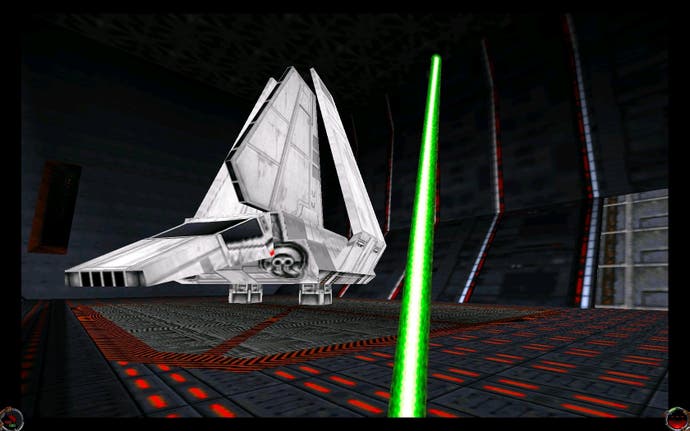Retrospective: Star Wars Jedi Knight: Dark Forces II
Having a blast.
Let me attempt to walk you through the order in which the Jedi Knight games appeared. It began with Star Wars: Dark Forces featuring Kyle Katarn's adventures, working in parallel with the original Star Wars films.
Kyle was but a soldier back then, but soon showed a propensity for the Force, which brings us to this, the peculiarly named Star Wars Jedi Knight: Dark Forces II. This is not to be confused with the expansion pack, Star Wars Jedi Knight: Mysteries of the Sith. Nor indeed Star Wars Jedi Knight II: Jedi Outcast, which was of course followed by Star Wars Jedi Knight: Jedi Academy. Erk. We shall call this game Jedi Knight, and all shall understand.
1997's Jedi Knight picks up a year after the end of Return of the Jedi. Katarn learns that a Dark Jedi, Jerec, has killed his father. Returning to his father's home he learns details of a map to the Valley of the Jedi where he will be able to avenge his father's demise, and rather significantly, gets given a lightsabre.
It turns out Katarn has latent Force powers - if only he'd known when fighting those Dark Troopers before! This of course means Jedi Knight becomes a far more elaborate shooter, not only offering the glowy fun-stick for fighting, but a collection of nano-powers (although of course Lucas wouldn't break that terrible news for a long, long time). So with the help of his buddy Jan Ors, it's time to leap around the galaxy.

And by crikey, it's good. It's very, very good. It's so good that you can only look down at the ground, shake your head in confusion, and slowly pen a letter to LucasArts asking them what the hell they were thinking when they abandoned FPS development and handed the reins over to Raven. With this, Dark Forces, and indeed the enormous Mysteries of the Sith expansion, LucasArts demonstrated a rare and brilliant skill with a genre that's so often so mediocre.
I'm not really interested in which game did what first, but more which games did what brilliantly. So while Jedi Knight was one of the first games to embrace Direct 3D, and an early adopter of 3D sound and dynamic lighting, the chronology does not matter. What matters is how effectively these tools were employed here, in such a way that they still maintain an impact 12 years later.
Certainly we take it for granted now that you can light a dark corridor, it doesn't make it any less charming to explore the danker areas of the game by wielding your lightsabre as a green torch. There's no doubt that we instinctively explore levels using ambient clues, but this doesn't diminish the thrill of hearing an AT-ST walker somewhere near to the left, and knowing to run. (Oh, and talking of walkers - I know there should be more complicated, nuanced reasons for choosing your alignment in the Star Wars universe, but one side has AT-ATs and AT-STs, and the other doesn't. Decision made.)
But before you get to lightsabres, Force powers and walkers, there's a surprising amount of old-school shooter to play through first. Katarn's adventures begin very modestly, fighting Gamorreans, Gran and Rodian with traditional blaster weapons and thermal detonators. In fact, it's very much in-keeping with the style of Dark Forces, keeping its cards close to its chest for a surprising amount of time.

